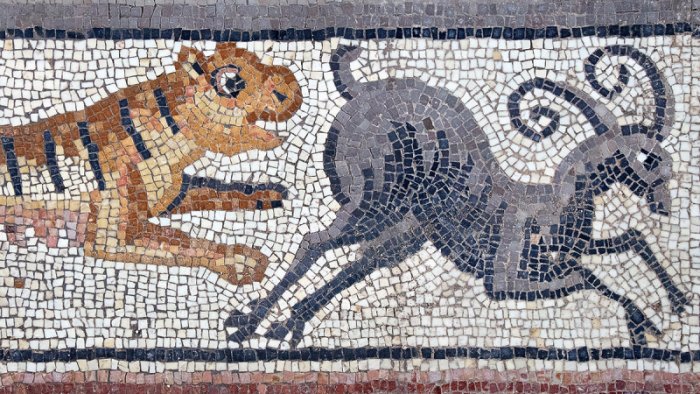Conny Waters – AncientPages.com – Scientists have uncovered a spectacular mosaic panel in the late Roman (ca. 400 C.E.) synagogue at Huqoq, an ancient Jewish village in Israel’s Lower Galilee. The panel, which identifies the mosaic donors or artists, decorates the floor just inside the main entrance.
The discovery was made by a team of specialists and students led by University of North Carolina at Chapel Hill professor Jodi Magness.

Tiger chasing ibex. Decorative border panel in the Huqoq synagogue mosaic in Israel. Credit: Jim Haberman
The newly discovered mosaic consists of a large panel, in the center of which is an enigmatic Hebrew inscription framed within a wreath. To the sides and below the wreath, an Aramaic inscription lists the names either of the donors who provided funding for the synagogue’s mosaics or the artists who made them, asking that they be remembered for good. The wreath is flanked on either side by lions resting their forepaws on bulls’ heads. The entire panel is surrounded by a decorated border showing animals of prey pursuing other animals.
This summer’s excavations also exposed additional sections of mosaic panels that were discovered in 2012 and 2013, which depict the episodes of Samson and the foxes as mentioned in Judges 15:4 and Samson carrying the gate of Gaza on his shoulders referenced in Judges 16:3.
The newly exposed sections include a Philistine horseman and a ᴅᴇᴀᴅ Philistine soldier with a striking classic face.
Excavations in 2022 uncovered a panel in the southwest aisle divided into three registers (horizontal strips) that depict an episode from Judges chapter 4: the biblical prophetess and judge Deborah under a palm tree, gazing at Barak, who is equipped with a shield; and the Kenite woman Jael (Yael) hammering a tent stake through the temple of the Canaanite general Sisera, who lies ᴅᴇᴀᴅ on the ground with blood gushing out of his head. These are the earliest known depictions of the biblical heroines Deborah and Jael.
The sweeping archaeological project at Huqoq has left an extraordinary legacy of historically significant finds, including:
- A Hebrew inscription surrounded by human figures, animals and mythological creatures including putti, or cupids.
- The first non-biblical story ever found decorating an ancient synagogue—perhaps the legendary meeting between Alexander the Great and the Jewish high priest.
- A panel depicting two of the spies sent by Moses to explore Canaan carrying a pole with a cluster of grapes, labeled “a pole between two” from Numbers 13:23.
- Another panel showing a man leading an animal on a rope accompanied by the inscription “a small child shall lead them” (Isaiah 11:6).
- Figures of animals identified by an Aramaic inscription as the four beasts representing four kingdoms in the book of Daniel, chapter 7.
- A large panel in the northwest aisle depicting Elim, the spot where the Israelites camped by 12 springs and 70 date palms after departing Egypt and wandering in the wilderness without water referenced in Exodus 15:27.
- A portrayal of Noah’s Ark.
- The parting of the Red Sea.
- A Helios-zodiac cycle.
- Jonah being swallowed by three successive fish.
- The building of the Tower of Babel
Archaeologists have discovered that in the early 14th century C.E. (the late medieval/Mamluk period), the synagogue was rebuilt and expanded in size. This development apparently occurred in the wake of the establishment of a new international highway connecting Cairo and Damascus that ran alongside Yakuk, Huqoq’s medieval name, and the rise of a tradition that the Tomb of Habakkuk was nearby, which became a focal point of late medieval Jewish pilgrimage.
See also: More Archaeology News
The 2022 and 2023 excavations also brought to light an enormous stone paved courtyard surrounded by a row of columns known as a colonnade to the east of the synagogue. In the late medieval period, the courtyard was reused, and a mᴀssive, vaulted structure of unknown function was built on top of it.
With the conclusion of this final season of excavations, the excavated area will be turned over to the Israel Antiquities Authority and the Keren Kayemet Le’Israel (Jewish National Fund), which plan to develop the site as a tourist attraction.
Written by Conny Waters – AncientPages.com Staff Writer





